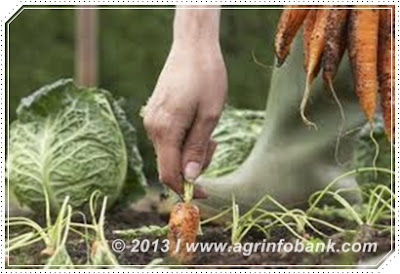Gardening is not too complex. Almost all of us—probably in grade school—planted a seed in a cup of dirt, watered it, and watched it grow. But creating a garden that produces fresh food and flowers all season is not so elementary, especially to those who did not grow up gardening.
So we've
compiled this guide to the basics of organic gardening and the keys to
success we've learned over the years. When you're done reading, look at
your thumb—you may see a tint of green that wasn't there before.
Planting Seeds
1. Make your bed. About three weeks before you are
ready to plant, after the soil has dried so that it doesn't clump when
you pick up a fistful, sink a fork into the earth. Loosen it down to
about 12 inches, add a half-inch layer of compost,
and rake the surface of your garden until it has no weeds, dirt clumps,
or big stones. Over the next three weeks, pull any weeds that come up.
Raking and then letting the soil sit for a few weeks brings out weed
seeds that were lurking in the soil.
2. Dig a furrow—or not. If you like symmetry and
order, carve out a shallow trench with a hoe or hand trowel. But you
don't have to plant in rows. You can organize your garden as a grid,
with plants at the four corners of each square, or you can choose not to
organize it at all. Whichever style you go with, dig shallow furrows or
holes for the seeds.
3. Water lightly.
Moisten but don't soak the soil. Watering before rather than after
planting the seeds protects them from being swamped, or washed up and
out of the soil.
4. Sow the seeds.
Spread the seeds through the trench or place two or three in each
planting hole. The seed packet tells you how far apart to plant them. If
you plant too closely, you can thin them after they come up and, in
many cases, eat the thinnings.
5. Cover with soil. As a rule of thumb, bury seeds
only about as deep as their diameter. Sprinkle soil on top of the seeds,
pressing gently to ensure they have contact with the soil. A few seeds,
such as lettuce and dill, need light to sprout, so cover them
sparingly. (Seed packets tell you if they need light to germinate.)
6. Keep moist. Sprinkle water on the seedbed whenever the surface is dry until all the seeds have sprouted.
Key to success: Add compost to planting holes to
improve the soil's structure, provide slow-release nutrients, and
activate the beneficial microbes in the soil.
Six Essential Tools
- Trowel
- Hand-weeding tool
- Hoe
- Pruners
- Fork
- Spade
Transplanting:
These steps apply to vegetables you get in packs at the garden center, as well as annual and perennial flowers.
1. Dig a hole. Make the planting hole as deep as the plant's container and about double the diameter.
2.
Water the plant. Give it a drink before planting, because until the
roots start growing, they can't draw water from the soil.
3.
Remove the plant from the pot. Place your hand on top of the pot, with
your fingers around the plant's stem. Turn the pot upside down and
gently squeeze it or push the plant out from the bottom with your other
hand. If you must tug it out, pull it by its leaves rather than the stem
(if a leaf comes off, no harm done; damage the stem, and the plant will
not survive).
4. Check the roots. If the roots have wrapped around and around the plant, gently pull a few loose with your fingers.
5.
Place it in the hole. Set the plant in the hole at the same depth it
was in its pot, generally where the stem meets the roots. Tomatoes are
an exception to this rule—plant them deeper.
6.
Replace soil and then water. Backfill the hole with the soil you
removed and press gently to ensure that the roots have solid contact
with the soil. Be sure the soil stays consistently moist until you see
the plant start to grow.
Key
to success: Transplant on an overcast day to give the plants a chance
to adjust to their new home without being withered by direct sun.
Managing Weeds:
 Weeds siphon water and nutrients away from your garden w, they can harbor pests,
and they sure can make your garden look a mess. But you don't need to
spray toxic herbicides, which are harmful to people, pets, and wildlife,
to keep plant invaders out of your organic garden. Use these strategies
instead.
Weeds siphon water and nutrients away from your garden w, they can harbor pests,
and they sure can make your garden look a mess. But you don't need to
spray toxic herbicides, which are harmful to people, pets, and wildlife,
to keep plant invaders out of your organic garden. Use these strategies
instead.
Mulch.
Keep your soil covered at all times to prevent light from reaching weed
seeds. Spread a thick layer (2 or more inches deep) of organic
mulch—straw, dried grass clippings, shredded leaves—on your garden each
spring and replenish it throughout the growing season. Bonus: The mulch
nourishes your soil as it decomposes. For even better weed protection,
use several sheets of newspaper, kraft paper (such as grocery bags), or
cardboard under these mulches. They are nearly impenetrable by weeds.
Hand-pull. Sounds like a lot of work,
we know. But pulling out a few weeds every day or at least every week
keeps them from getting out of control and brings you up close to your
garden so you can inspect your plants for problems. Keep a bale of straw
or a pile of grass clippings on hand so you'll have mulch on demand to
help prevent weeds from returning after you've pulled them.
Hoe. Use a hoe's sharp edge to sever weed stems
from their roots just below the soil surface. Forget about the
square-headed traditional garden hoe for this job—get a stirrup-shaped
oscillating or a swan-neck hoe instead. To hoe your garden without
cultivating a backache, hold the hoe as you would a broom.
Spread corn. You can suppress the growth of weed
seeds early in the season by spreading corn-gluten meal. This works best
in established lawns. Corn-gluten meal, a by-product of corn processing
that is safe for people, pets, and wildlife,
inhibits the germination of seeds and fertilizes at the same time. Bear
in mind, once the weeds have grown beyond the sprout stage, corn gluten
does not affect them. Also, corn gluten doesn't discriminate between
seeds you want to sprout and those you don't want, so avoid using
corn-gluten meal where and when you've sown seeds.
Solarize. Where you have a persistent weed problem
or you need to clear a thick mat of weeds from a brand-new bed, enlist
the sun's help. In late spring or early summer, pull, hoe, or rake out
as many weeds as you can from the bed. Then moisten the soil and cover
it with a tight layer of clear plastic, weighting or burying the edges.
Leave the plastic in place for six weeks so the sun cooks any remaining
weed seeds.
Be persistent. This is your most important
long-range weapon against weeds. Mulch, and pull or hoe the weeds for a
few minutes whenever you visit your garden. Do these things consistently
for a few seasons, and you will slowly but surely expel problem
invaders for good.
Key to success: Weeds come out easily when the soil
is moist, so think of a summer rainstorm as an opportunity to free your
garden from a weed infestation.
Use This.....................Not That
Fish and seaweed fertilizer..Miracle-Gro
Insecticidal soap............Sevin
Clove oil herbicide..........Roundup
Compost......................Bagged synthetic fertilizer
Fish and seaweed fertilizer..Miracle-Gro
Insecticidal soap............Sevin
Clove oil herbicide..........Roundup
Compost......................Bagged synthetic fertilizer
Controlling Pests:
Whenever you see insects in your garden, remember this: Most are no
threat to plants, many are even beneficial, and all of them, even the
pests that eat your plants, are an integral part of the ecosystem you
are cultivating. But what do you do when the pests seem to have the
upper hand? You don't want to enforce a "no-fly zone" with pesticides.
They're dangerous for you to have and to use, and they harm wildlife and
contaminate water. Instead, use safe, organic techniques and products
to keep the pests in balance.
Grow healthy plants. The best defenses against
insect attack are preventive measures. Pests target weak or unhealthy
plants, so choose plants that are suited to the conditions you are
putting them in and they'll be less stressed. Don't let plants be too
wet, too dry, or too shaded. Use lots of compost, but be sparing with
high-nitrogen fertilizers, if you must use them at all.
Integrate, don't segregate. Mix different
vegetables, herbs, and flowers together in your beds. This keeps pests
from zeroing in on a whole crop of their target plant.
Encourage Pests' Predators. The most effective and
natural way to control pests is to rely on the food chain. Plant herbs
and flowers among your vegetables to lure predatory insects such as
ladybugs and green lacewings, which feed on flowers' nectar while their
larvae consume pests. Put out a birdbath to enlist the appetites of
songbirds to your cause. Treat toads, lizards, and garter snakes as
welcome allies, too.
Build Barriers. Row cover
is a woven fabric that lets light, air, and water reach plants, but
keeps pests (including deer) away from them. You'll find it in local
garden centers, in catalogs, and online. The best-known brand is Reemay.
Target The Treatment. When prevention is no match
for infestation, take the time to choose the right organic tool to solve
your problem. Start by making sure you have correctly identified the
pest and confirmed it is the cause of the symptoms you've found. Consult
your local Cooperative Extension office (csrees.usda.gov) if you need
help.
Then, depending on the pest, you can arm yourself with soap or
hot-pepper sprays, horticultural oil, or Bacillus thuringiensis, a
naturally occurring bacterium that disrupts the digestion of
caterpillars and other leaf-eaters.
Surrender. As we said, insects attack plants under
stress. Do you have enough healthy plants to spare the sickly ones? Can
you restore sickly plants to robust health so they can resist insect
attack? If not, let the pests do their worst, then watch as their
predators flock to your garden and protect your healthy plants.
Key To Success: Check the undersides of leaves when applying organic pest control—insects often hide out of sight.
Source of Article: http://www.organicgardening.com/











0 comments:
Post a Comment